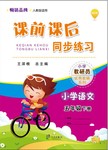
 教学练新同步练习系列答案
教学练新同步练习系列答案 课前课后同步练习系列答案
课前课后同步练习系列答案 课堂小作业系列答案
课堂小作业系列答案 黄冈小状元口算速算练习册系列答案
黄冈小状元口算速算练习册系列答案 成功训练计划系列答案
成功训练计划系列答案 倍速训练法直通中考考点系列答案
倍速训练法直通中考考点系列答案科目:高中英语 来源:2014届河南开封高三接轨考试英语卷(解析版) 题型:完型填空
阅读下面短文,从短文后各题所给的四个选项(A、B、C和D)中,选出可以填入空白处的最佳选项,并在答题卡上将该项涂黑。
Language is the most astonishing behavior in the animal kingdom. It is the species-typical behavior that sets humans completely 36 from all other animals. Language is a means of 37 , but it is much more than that. Many animals can 38 . The dance of the honeybee communicates the location of flowers 39 other members of the hive (蜂群). But human language permits communication about anything, 40 things like unicorns (独角兽) that have never existed. The key 41 in the fact that different words can be 42 together in different ways, according to 43 to communicate different meanings.
Language is the most important learning we do. Nothing can 44 humans so much as our ability to communicate abstract 45 , whether about the university, the mind, love, dreams, or ordering a drink. It is an extremely complex 46 that we take for granted. Indeed, we are not aware of most 47 of our speech and understanding. Consider what happens when one person is speaking to 48 . The speaker has to translate thoughts into 49 language. Brain imaging studies suggest that the time from thoughts to the 50 of speech is extremely fast. Only 0.04 seconds! The listener must hear the sounds to 51 what the speaker means. He must use the sounds of speech to 52 the spoken words, understand the pattern of 53 of the words (sentences), and finally 54 the meaning. This takes somewhat longer, a minimum of about 0.5 seconds. But once started, it is of course a(n) 55 process.
1.A. apart B. off C. up D. down
2.A. advertisement B. communication C. discovery D. invention
3.A. transfer B. move C. convey D. communicate
4.A. to B. from C. over D. on
5.A. only B. almost C. even D. just
6.A. stays B. situates C. hides D. lies
7.A. stuck B. joined C. rung D. controlled
8.A. rules B. scales C. laws D. standards
9.A. combine B. contain C. define D. declare
10.A. activities B. thoughts C. effects D. chances
11.A. expectation B. progress C. process D. produce
12.A. aspects B. abstracts C. angles D. assumptions
13.A. anybody B. another C. other D. everybody
14.A. body B. gesture C. written D. spoken
15.A. growing B. fixing C. beginning D. building
16.A. put out B. take down C. draw up D. figure out
17.A. identify B. locate C. reveal D. discover
18.A. performance B. organization C. design D. show
19.A. regulate B. justify C. release D. interpret
20.A. slow B. interesting C. continuous D. serious
查看答案和解析>>
科目:高中英语 来源:2012-2013学年北大附中河南分校高考押题英语卷(解析版) 题型:阅读理解
What happens inside the skull of a soccer player who repeatedly heads a soccer ball? That question motivated a challenging new study of the brains of experienced players that has caused discussion and debate among soccer players, and some anxiety among those of us with soccer-playing children.
For the study, researchers at the Albert Einstein College of Medicine in New York selected 34 adults, men and women. All of the volunteers had played soccer since childhood and now competed year-round in adult soccer leagues. Each filled out a detailed questionnaire developed especially for this study to determine how many times they had headed a soccer ball in the previous year, as well as whether they had experienced any known concussions (脑震荡) in the past.
Then the players completed computerized tests of their memory and other learning skills and had their brains scanned, using a complicated new M.R.I. technique which can find structural changes in the brain that can’t be seen during most scans.
According to the data they presented at a Radiological Society of North America meeting last month, the researchers found that the players who had headed the ball more than about 1,100 times in the previous 12 months showed significant loss of white matter in parts of their brains involved with memory, attention and the processing of visual information, compared with players who had headed the ball fewer times.
This pattern of white matter loss is “similar to those seen in traumatic (外伤的) brain injury”, like that after a serious concussion, the researchers reported, even though only one of these players was reported to have ever experienced a concussion.
The players who had headed the ball about 1,100 times or more in the past year were also generally worse at recalling lists of words read to them, forgetting or fumbling the words far more often than players who had headed the ball less.
1.The passage is most probably a______.
A.news report B.research report
C.story for soccer players D.text for doctors
2.In which way can we find the structural changes in the brain?
A.Computerized test. B.Questionnaire..
C.Scanning. D.M.R.I. technique.
3.From the passage we can conclude that frequent heading may have_____.
A.significant effect on brain B.little effect on one’s brain
C.nothing to do with the brain injury D.one’s memory improved
4.The underlined word "fumbling" is closest in meaning to______.
A.remembering B.misunderstanding
C.recalling D.missing
查看答案和解析>>
科目:高中英语 来源:2015届陕西省高一上学期期中考试英语试卷(解析版) 题型:阅读理解
David Brown and Anne are two patients in the Adult Day Care Program at Mercy Hospitals. David Brown is seventy-two years old. He’s friendly and likes to talk. He lives with his wife in the city. But David is becoming forgetful. His wife says, “He’ll heat up some soup, then forget to turn off the gas.” She is sixty-one and still works. She is worried about leaving her husband alone.
Anne is eighty and lives with her 60-year-old daughter. Her daughter says that she needs a rest. “Mom follows me everywhere. She follows me when I read newspapers. I need a rest and she does, too.”
And so, several times a week, David and Anne’s families take them to the Adult Day Care Center. Many hospitals have this program. Patients come to the Center for a full or half day, from one to five days a week. All the patients live with their families and most are old people.
Mrs. Carol Johnson is the director of the Center. She says, “We are offering both the patients and their families a service of great value. Patients have the chance to get out of their houses. Husbands, wives or grown children can work or have a rest. Most important of all, families are able to stay together.”
1.Why did David Brown become a patient of the Adult Day Care Center?
A. Because he is seventy-two years old.
B. Because he is lonely at home.
C. Because he is becoming forgetful.
D. Because he is seriously ill.
2. What happens to Anne’s family?
A. Her daughter is too old to look after her.
B. Anne cleans all the rooms everyday.
C. Her daughter doesn’t want Anne to live with her.
D. Her daughter is very tired because Anne always follows her.
3.Adult Day Care Center is run by ____.
A. hospitals B. schools C. churches D. government
4. Which statement is NOT true about the patients of the Center?
A. Most patients are old people.
B. All the patients live with their families.
C. The patients learn many things in the Center.
D. The patients come to the Center six days a week.
5.Which of the following statements is NOT the reason why the Center is offering a valuable service?
A. Families are able to stay together.
B. Husbands, wives or grown children can work or have a rest.
C. Patients have the chance to go out of their houses.
D. The patients there are given the best medicine and the best operation.
查看答案和解析>>
科目:高中英语 来源:2015届云南昆明官渡第二中学高一上第二次阶段性检测英语卷(解析版) 题型:阅读理解
Everybody hates rats(老鼠). But in the earthquake capitals of the world—Japan, Los Angeles, Turkey—rats will soon be man’s new best friends.
What happens after an earthquake? We send in rescue dogs. Why? Because they can smell people. They help rescuers to find living people. But dogs are big and they can’t get into small spaces. So now a new research project is using a smaller animal to save lives: the rat.
How does it work? First, the rat is trained to smell people. When this happens, the rat’s brain gives a signal(信号). This is sent to a small radio on its back and then the rescuers follow the radio signals. When rat’s brain activity jumps, the rescuers know that someone is alive. The rat has smelled that person.
Although there are already robots which can do this job, rats are better. Christian Linster at Cornell University, New York, says, “Robots’ noses don’t work well when there are other smells around. Rats are good at that. ” Rats can also see in the dark. They are cheaper and quicker to train than dogs, and unlike robots, they don’t need electricity!
The “rat project” is not finished, but Julie Ryan of International Rescue Corps in Scotland says, “It would be fantastic. A rat could get into spaces we couldn’t get to, and a rat would get out if it wasn’t safe. ” Perhaps for the first time in history, people will be happy to see a rat in a building, but only after an earthquake, of course.
1. In the world earthquake capitals, rats will become man’s best friends because they can ______.
|
A.take the place of man’s rescue jobs |
|
B.find the position of people alive who are trapped in buildings |
|
C.serve as food for people alive who are trapped in buildings |
|
D.get into small spaces |
2.From the third paragraph we know the rescuers can judge a person is alive by ______.
|
A.the noise made by the rat |
|
B.the rat’s unusual behavior |
|
C.the signal sent by the radio on the rat’s back |
|
D.the smell given off by the person |
3.In doing rescue jobs, ______.
|
A.rats smell better than dogs |
|
B.dogs don’t need to be trained to smell people |
|
C.robots’ sense of smell can be affected by other smells around |
|
D.rats can see in the dark and they are smaller than robots |
4.Rats have all the following advantages EXCEPT that ______.
|
A.they are more fantastic than other animals |
|
B.they are less expensive to train than dogs |
|
C.they don’t need electricity |
|
D.they are small and can get into small places |
查看答案和解析>>
科目:高中英语 来源:湖南省慈利县2009-2010学年度高一下学期期中考试英语试题 题型:阅读理解
.
第三部分:阅读理解
What happens to old school buses when they can no longer safely carry kids to school? Most go to waste factories to be changed into pieces of metal. But a few of the old vehicles (车辆) find new lives in the center of Africa. Most of those buses end up on the streets of Kinshasa, the capital of the Democratic Republic of Congo.
The Kinshasa buses are that yellow color, which makes them stand out (突出) in the city’s heavy traffic, but the buses don’t look at all as they did in the United States. In Kinshasa their taillights(尾灯) are almost all missing or broken. They don’t obey traffic rules and often race around the city very fast. The buses compete with motorcycles, cars, trucks, and other vehicles for space on the road. They make loud sounds when moving, and they are packed with people carrying loads of goods, such as fish, milk, beans and onions.
However, Kinshasa business people love the old, yellow buses, which they buy from American companies, because the vehicles are strong, reliable (可依靠的) and inexpensive. A used bus sells for about $2,000 in Congo. A new bus is more expensive. In the United States, a new school bus with all its lights working costs about $80,000.
The fare (票价) to travel across the city is usually about 30 US cents. “Transport is a big problem in Kinshasa,” says passenger Bruce Kingambo. “But the yellow buses help people here get around.”
56.The underlined sentence in the first paragraph means “In the center of Africa some old US school buses can be_________.”
A.useful B.expensive C.free D.new
57.Before the school buses leave America for Congo, they_________
A.have broken taillights
B.don’t obey the traffic rules and move at full speed
C.carry many people and goods
D.don’t compete with other vehicles
58.How many used buses can you buy in Congo for the price of a completely new school bus in the USA?
A.10. B.20. C.30. D.40.
59.The passage mainly tells us _________
A.how to use old school buses
B.about new lives for old school buses
C.to try to take old school buses
D.how to drive old school buses
查看答案和解析>>
湖北省互联网违法和不良信息举报平台 | 网上有害信息举报专区 | 电信诈骗举报专区 | 涉历史虚无主义有害信息举报专区 | 涉企侵权举报专区
违法和不良信息举报电话:027-86699610 举报邮箱:58377363@163.com